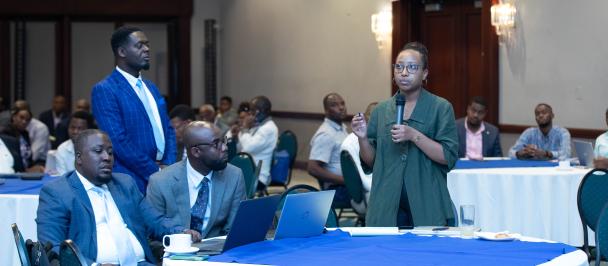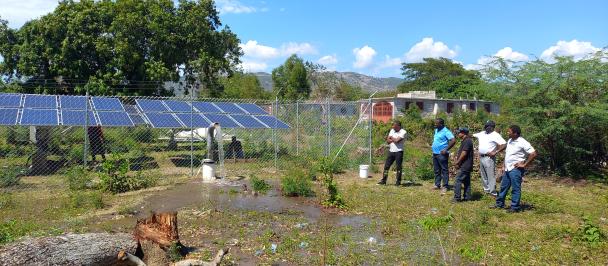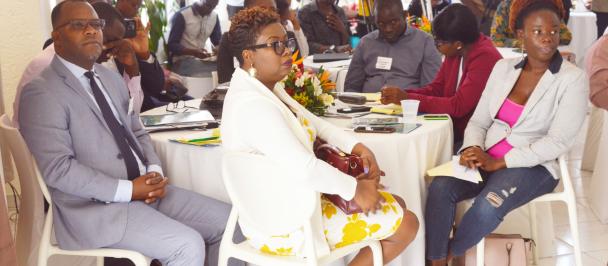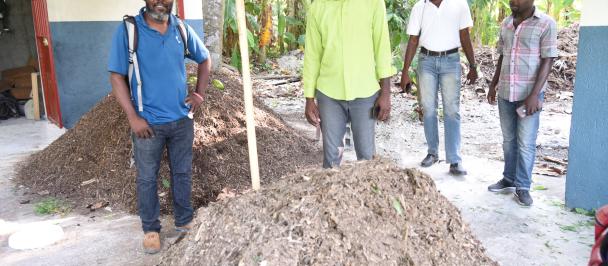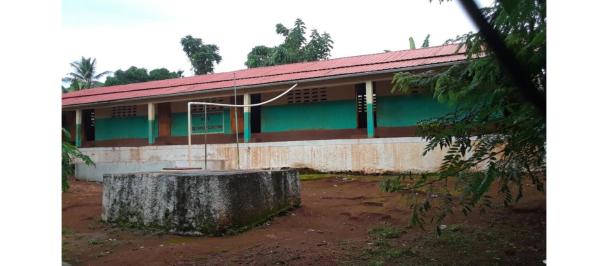By Mickens Mathieu, UNDP Haiti AccLab Head of Exploration
Spotlight on the law of September 21, 2017: to better address the challenges of the solid waste management system in Haiti
22 mars 2022
Photo: Adobe Stock Photo
Since its promulgation, the September 21, 2017[1] law has been a pillar of the regulatory and institutional framework of the solid waste management system in Haiti. In general, it enshrines the creation, mission and attributions of the National Solid Waste Management Service (SNGRS), defines its supervisory institution and its administrative structures.
This law was the focus of discussions and exchanges during the month of July 2021, conducted by the UNDP Haiti Acceleration Lab with stakeholders in the solid waste management system in Haiti This contribution of the laboratory is perfectly consistent with UNDP's long experience in the solid waste management sector in Haiti. Indeed, currently, UNDP is implementing a project to strengthen the solid waste management system in the municipalities of Jeremie and Ouanaminthe, with financial support from the Government of Japan in the amount of US$8.5 million[2] . In addition, UNDP is supporting the Ministry of Environment (MoE) in a project aimed at manufacturing fuel briquettes from organic waste in the Carrefour-Feuille neighborhood in the Port-au-Prince municipality[3]. A similar project in the same area[4] had already been implemented from 2006 to 2011 by UNDP.
In the present article, the laboratory proposes to analyze the various strategic and operational changes that the September 21, 2017 law has brought to the solid waste management sector in Haiti. This piece will also look at the persistence of certain obstacles negatively impacting the results obtained by the actors and the relevance of institutional mechanisms to be implemented in order to ensure its strengthening and a better adaptation of its prescriptions in the field of solid waste management in Haiti.
The replacement of the decree of March 3, 1981 by the law of September 21, 2017: for lasting institutional changes
The law of September 21, 2017 is one of the key components of the regulatory framework governing the solid waste management system in Haiti. This law establishes, organizes and operates the National Solid Waste Management Service (SNGRS).
The publication of this new law was a clear and concrete indicator of the willingness of public authorities to put solid waste management at the heart of government action, in order to fill regulatory gaps and to provide appropriate solutions. The changes at the level of the institutional architecture, the specification of the attributions of some key state institutions called to intervene in the solid waste sector, are among the most striking facts of this law.
The law of September 21, 2017 replaces the Decree of March 3, 1981, which was recognized as the first national normative framework specifically addressing the issue of solid waste management in the country, particularly in Port-au-Prince, the country's capital. This same decree created the Metropolitan Solid Waste Collection Service (SMCRS), which was also the first state institution in charge of waste management.
Historically, two years after the promulgation of the decree of March 3, 1981, the presidential decree of April 21, 1983 extended the SMCRS's areas of intervention to other municipalities in the metropolitan region: Carrefour, Pétion-Ville and Delmas. In addition to this territorial extension, the decree formally establishes the Truitier site (communal section of Varreux) as a space reserved for the treatment and disposal of waste from the Port-au-Prince metropolitan area. The decree of April 21, 1983 formally prohibits the establishment of illegal dumping sites, open-air burning and ragging on the Truitier site (Bras, 2010; MTPTC, 2010).
SNGRS replaces SMCRS and the Ministry of the Environment (MOE) becomes the supervisory institution
One of the major facts accompanying the promulgation of the law of September 21, 2017 is the creation of SNGRS, an autonomous institution, with the mission of ensuring the management of solid, medical and high toxicity waste in the 10 departments and 149 municipalities of the country. The creation of SNGRS replaces and ends the activities of the SMCRS created thirty-six years (36 years) earlier by the decree of March 3, 1981, which served only municipalities in the metropolitan area.
According to the requirements of the law of September 21, 2017, the responsibilities of SNGRS are not only limited to the activities of storage, collection and transportation of waste. Its responsibilities also extend to waste recovery, including, sorting, treatment, processing and recycling. All of its activities should be planned and implemented in conjunction with the local authorities. In addition, given its national scope, SNGRS is called upon to establish its offices in the 10 departments and 149 municipalities of the country, in order to render concrete the services related to its mission as well as accessible to the national population.
Similarly, in addition to the aforementioned operational tasks, SNGRS is called upon to implement initiatives ensuring the regulation of the solid waste sector through the formulation and enforcement of standards and sanctions against violators.
The law of September 21, 2017, also established the Ministry of the Environment (MDE) as the supervisory institution of SNGRS. Specifically, the MDE plays the role of chairman of the SNGRS Board of Directors composed of seven members, including the Ministry of Public Works, Transport and Communications (vice-president), the Ministry of Public Health and Population (member), the Ministry of Economy and Finance (member), the Ministry of Tourism (member), the Ministry of the Interior and Territorial Collectivities (member) and three representatives of the National Federation of Mayors (FENAM). The Board's responsibilities include defining and implementing the strategic objectives supervising the activities, adopting internal regulations, and approving the plans, action programs and budgets of the SNGRS.
In addition to the Board of Directors, the law of September 21, 2017 provides for the establishment, structuring and attributions of the General Management, the Management Council of the SNGRS. Said Council includes: a) the Directorate of Solid Waste Collection; b) the Directorate of Solid, Medical and High Toxicity Waste Processing; c) the Directorate of Administrative Affairs and Budget; d) the Directorate of Education and Communication.
Need to put in place mechanisms to strengthen and better adapt the law of September 21, 2017
Consultations conducted by UNDP Haiti's Innovation Acceleration Lab with government actors, mayors, and specialists on the subject highlighted the need to work on better implementation and adaptation of the September 21, 2017 law. These actors placed particular emphasis on the need to ensure the cohesion of the tasks and attributions of the SNGRS and the municipalities.
Along the same lines, many of the actors who took part in the discussions felt that it would be desirable for the NSSRM to specialize exclusively in the area of control and regulation, leaving collection, transportation, treatment, landfilling and recovery operations to the municipalities and other private sector actors. In their view, such a strategy would help to better harmonize the interventions of the NSSRM and the municipalities in the field of solid waste management in Haiti.
The ideas expressed by the actors consulted by the laboratory coincide with the results of a study conducted by Lacour (2020), according to which 73% of the heads of institutions interviewed believe that the NGRS can play the role of regulation and arbitration of the sector. Stakeholders who participated in this study were from private companies, state agencies, NGOs, donors, and academic centers.
Similarly, according to the points of views of the actors consulted by the laboratory, the law of September 21, 2017 should be reinforced by procedures, application measures, charters of responsibilities specifically addressing key components of solid waste management, in particular, collection, storage or packaging, transportation, treatment, disposal, and processing of waste. These enforcement measures can establish the responsibilities, rights and duties of actors (municipalities, private companies, NGOs, community-based organizations), as well as penalties and fines for specific infractions. Such measures are even more important in the management of biomedical waste (including infectious, anatomical, sharps, pharmaceutical, and radioactive waste) and other highly toxic waste found in the country.
It is important to note that the September 21, 2017 law gives central attention to solid, medical, and high-toxicity waste. However, it does not give precise definitions of their content. This situation may cause confusion, problems relating to the scope of actions, or even inaction by some actors, including producers, waste recovery companies and regulatory bodies called to ensure better management of solid waste in their spheres of influence.
According to the analyses carried out by UNEP and UNITAR (2013), the application of the provisions of the regulatory framework will have multiple impacts in solid waste management. These institutions emphasized a) better circumscription and orientation of actors in real life; b) the establishment of a minimum level of protection of the health of the population and its environment (air, water); c) the granting of permits; d) the limitation of manufacturing methods of certain products that can have harmful effects on health and the environment; e) the establishment of responsibilities of waste producers; f) the establishment of basic infrastructure specifically dedicated to waste management.
In order to maximize the impacts of the above-mentioned provisions, the actors who took part in the discussion and exchange sessions lead by the laboratory highlighted the relevance of initiatives that would ensure better dissemination and awareness-raising among the population as well as state and non-state actors involved in the solid waste management sector, in particular on the content of the legal texts and the good practices necessary for their application. This same line of thought is also valid for the collection, processing and continuous dissemination of data on the sector. Similarly, awareness campaigns can be targeted at key socialization spaces, such as families, schools, churches, among others. These awareness campaigns could pay particular attention to integrating the principles of the 4Rs (Reduce, Reuse, Repair and Recycle waste) into the daily activities of the population. In addition to these measures, stakeholders have proposed the establishment of incentive mechanisms to increase the number of private companies and NGOs, consulting firms and community organizations involved in the solid waste management sector, especially in certain key activities such as recycling and composting using artisanal or industrial technologies.
Beyond the aforementioned considerations, stakeholders emphasize the need for regulatory frameworks to be accompanied by improvements in the financial, technical, material and informational capacities of central and local institutions involved in the solid waste sector in Haiti. The situation is even more difficult for municipalities that have very few financial, material and human resources to provide basic services for the collection, transportation and disposal of solid waste in Haiti. The lack of pricing instruments at the municipal level is another obstacle that hinders local institutions from achieving these goals. This same reality can be observed at the level of the SNGRS, which, due to a lack of resources, continues to concentrate its activities in the metropolitan area of Port-au-Prince. In this context, its absence is felt in the 10 departments of the country, while it is called to intervene directly in the management of activities related to solid waste management and to regulate the interventions of other actors. This situation is no different in the case of the Ministry of Public Health and Population (MSPP), which is responsible for the management (collection, treatment and disposal) of biomedical waste, although it has very few resources allocated to this activity.
Bibliography
Bras, Anie (2010). Elements for a definition of the problem of urban cleanliness in Haiti: The case of Port-au-Prince, Thesis to obtain the degree of doctor, National Institute of Applied Sciences of Lyon (France), Quisqueya University, Haiti.
Lacour, Joaneson (2020), Technical Proposals for Legislative and Institutional Reform of the Solid Waste Management Sector, Report of the Online Survey-MDE/SNGRS-PNUD-L3, Project to Strengthen the Solid Waste Management System in Haiti, Port-au-Prince, Haiti.
MTPTC (2010). Elaboration of a strategic solid waste management policy for the Port au Prince metropolitan area, Port-au-Prince, Haiti.
UNEP, UNITAR (2013). Guidelines for establishing national waste management strategies: moving from challenges to opportunities, Nairobi, Kenya.
[1] http://ciat.bach.anaphore.org/file/misc/366_20170809.pdf
[2] https://www.ht.undp.org/content/haiti/fr/home/presscenter/pressreleases/2019/le-mde-a-lance-le-projet-de-renforcement-du-systeme-de-gestion-d.html
[3] https://www.youtube.com/watch?v=B3hJRC_v_QA[4]https://info.undp.org/docs/pdc/Documents/HTI/00060216_PID53725%20_Evaluation%20finale%20D%C3%A9chets%20Solides_Oct.%202011.pdf

 Locations
Locations
